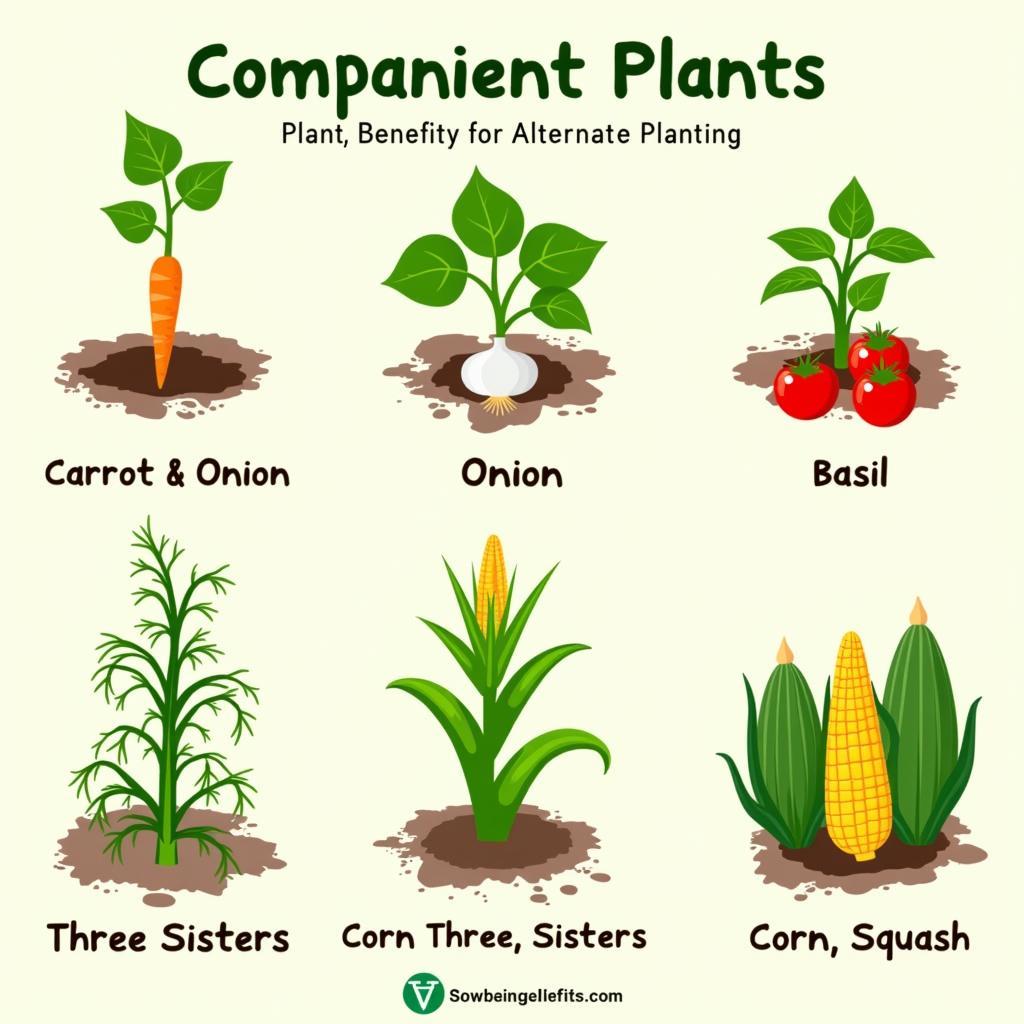Alternate Planting is a gardening technique that involves strategically planting different crops next to each other to maximize space, improve soil health, and boost yields. This method can be a game-changer for gardeners of all levels, from small balconies to expansive backyards. It leverages the natural relationships between plants to create a harmonious and productive garden ecosystem.
Understanding the Benefits of Alternate Planting
Alternate planting, also known as companion planting or intercropping, offers a multitude of benefits for your garden. By carefully selecting plant companions, you can create a symbiotic environment where different species support each other’s growth and development. One of the key advantages is pest control. Certain plants naturally repel insects that may harm their neighbors, reducing the need for chemical pesticides. For example, planting marigolds alongside tomatoes can deter nematodes and whiteflies. Another benefit is improved soil health. Different plants have different nutrient requirements, and by alternating them, you can prevent nutrient depletion and improve soil structure. Leguminous plants like beans, for instance, fix nitrogen in the soil, benefiting neighboring plants like corn or squash. Finally, alternate planting maximizes space utilization, allowing you to grow more in a smaller area. This is particularly useful for urban gardeners or those with limited space.
Choosing the Right Plant Combinations for Alternate Planting
Successful alternate planting relies on choosing compatible plant pairings. Some plants have allelopathic properties, meaning they release chemicals that inhibit the growth of nearby plants. It’s crucial to avoid these combinations. Researching plant families and their interactions can help you make informed decisions. A classic example of a beneficial pairing is the “Three Sisters” method practiced by Native Americans: corn, beans, and squash. The corn provides support for the beans, the beans fix nitrogen, and the squash’s large leaves suppress weeds and retain moisture. Other successful combinations include carrots and onions, basil and tomatoes, and lettuce and radishes.
 Các loại cây trồng xen canh
Các loại cây trồng xen canh
Implementing Alternate Planting in Your Garden
Putting alternate planting into practice is relatively straightforward. Start by planning your garden layout, considering the mature size of each plant. Adequate spacing is essential to prevent overcrowding. You can alternate plants in rows, blocks, or even within the same hole, depending on the species. When planting seedlings, ensure they are healthy and free from pests. Regular monitoring and maintenance, such as watering, fertilizing, and weeding, are crucial for optimal results. Remember to rotate your crops annually to further enhance soil health and prevent pest buildup.
Alternate Planting: A Sustainable Gardening Practice
Alternate planting isn’t just about maximizing yields; it’s also a sustainable gardening practice. By reducing the need for chemical pesticides and fertilizers, you’re minimizing your environmental impact. It promotes biodiversity, creating a healthier and more resilient garden ecosystem. Furthermore, it can lead to reduced water consumption, as the diverse plant cover helps retain soil moisture.
Conclusion
Alternate planting is a powerful technique that can transform your gardening experience. By understanding the principles of companion planting and choosing the right combinations, you can create a thriving, productive, and sustainable garden. Embrace the power of alternate planting and enjoy the bountiful rewards of a harmonious garden ecosystem.
FAQ
-
What is alternate planting?
Alternate planting is a gardening technique where different crops are strategically planted together to benefit each other. -
Why should I use alternate planting?
Alternate planting helps control pests, improve soil health, and maximize space utilization. -
What are some examples of good companion plants?
Carrots and onions, basil and tomatoes, and the “Three Sisters” (corn, beans, and squash) are good examples. -
Can any plants be planted together?
No, some plants have allelopathic properties and should not be planted together. -
How do I start alternate planting?
Plan your garden layout, choose compatible plant pairings, and ensure proper spacing. -
Is alternate planting sustainable?
Yes, alternate planting reduces the need for chemicals and promotes biodiversity. -
Where can I find more information about alternate planting?
You can find more information online and in gardening books.
Situations and Frequently Asked Questions
Scenario 1: New gardener struggling with pests in their tomato plants.
Question: What can I plant near my tomatoes to help control pests?
Answer: Consider planting basil, marigolds, or onions near your tomatoes to deter common pests.
Scenario 2: Gardener with limited space wanting to maximize yield.
Question: How can I grow more vegetables in a small garden bed?
Answer: Alternate planting can help you maximize space by intercropping compatible plants.
Suggested Further Reading
- Other articles on our website about companion planting and pest control.
- Links to external resources about sustainable gardening practices.
Need Help?
Contact us for support: Phone: 0909802228, Email: doibongda@gmail.com Or visit us at: 101 Đ. Lý Chiêu Hoàng, Phường 10, Quận 6, Hồ Chí Minh, Việt Nam. We have a 24/7 customer service team.